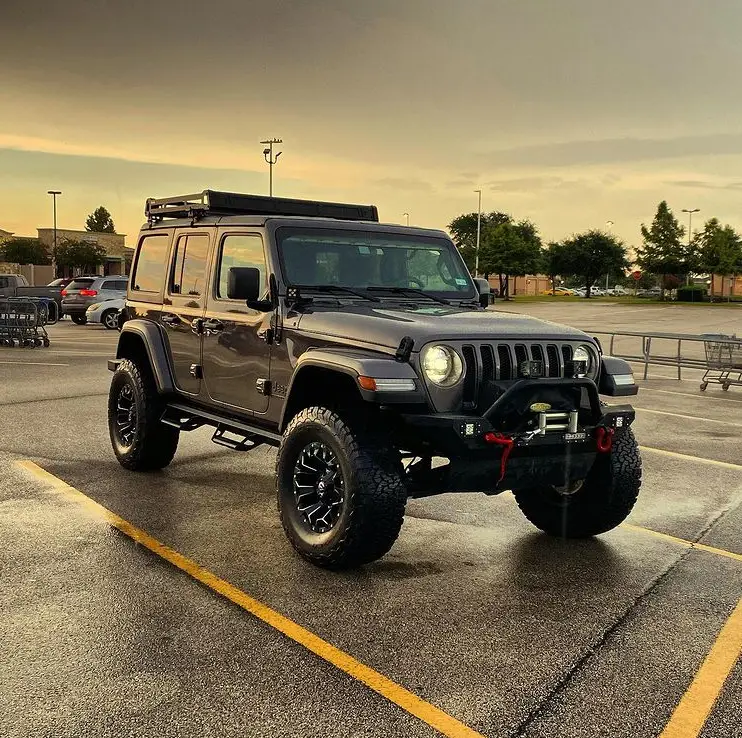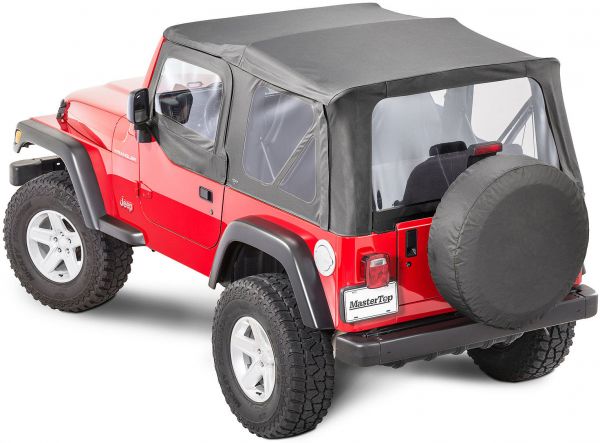Clicking.
Grinding.
Scraping.
These dreaded words can describe a litany of situations that no Jeep owner wants to find themselves dealing with, especially when they’re out on the trail. It’s one thing to encounter an issue from the comfort of your driveway but another whole animal to discover a major issue miles away from civilization and practical help. This is especially true if you’re looking to purchase a Jeep second-hand since you’ll often have no idea what problems the previous owners dealt with.

So, what can you do? The best thing to have in your arsenal is a guide to the most common problems that plague Jeeps and the best way to take care of these potentially challenging issues.
Don’t worry, we got your back! Let’s talk about common Jeep Wrangler Problems.
2018-Present Jeep Wrangler JL Common Problems & Recalls
Poor Fuel Economy
While the turbo-diesel and turbo four-cylinder fare better, most JL’s have a combined EPA city/highway fuel economy rating in the low 20’s. Suffice to say that is less than stellar and on par with many full-size pickups and large SUVs. Obviously, some of that has to do with the gearing, and this may not be a concern if you don’t drive your JL daily, but it is something to keep in mind.
Jeep JL Recalls
The JL is relatively new and debuted in 2018, although it does fare better than its predecessor. However, we will list some of the known major recalls.
- Poor welds on the front track bars: 2018-2019
- Stalling due to an issue with the powertrain module: 2017-2018
- Cruise control may not disengage: Affects numerous FCA vehicles from 2014-2018
- Seat belt retractor may not lock in the event of an accident: 2019
Note: This is not a comprehensive list, and if you are in the market for a used JL, we recommend checking with your local Jeep dealership to verify if there are any recalls and/or if they have been addressed.
The Unknowns and Price
While it is too soon to judge the JL’s long-term reliability, the 2018 and 2019 models receive an average JD Power score although it improved for 2020. However, a safe bet is that it will be better than the JK.

Lastly, Wranglers are expensive and tend to hold their value. Likewise, the parts shortages due to the Covid-19 pandemic have not helped, and a used 2020 Wrangler sells for nearly the same price as a new model. Not to mention, a new and spartanly equipped base model Sport starts in the low 30’s. Adding options or moving up to the Sahara or Rubicon can bump that up to well over $40,000.
2007-2017 Jeep Wrangler JK Common Problems & Recalls
2007, 2008, and 2012 Wranglers
The 2007, 2008, and 2012 models are generally regarded as the worst years for the Wrangler, and there are too many problems to list here. The Totally Integrated Power Module was among the most notable, and replacing it typically costs well over $1,000. Likewise, the 3.8L V6 from 2007-2011 was known for excessive oil consumption, and suffice to say, replacing an engine is not cheap. Lastly, the 2012 Wrangler has the dubious honor of being regarded as the least reliable model of them all.
Leaking Top
While this is nothing new, and the same problem occurred on the TJ, we would like to think this would have been ironed out by now. Granted, it is more of a nuisance than a deal-breaker, but it is worth mentioning.
Not the Best Years
While the above-mentioned years may be the worst, many will agree that the JK represented a step back for Jeep, although Mercedes heavily influenced its design. Granted it was still a capable off-roader, it marked a trend towards civility and creature comforts for the Jeep brand. As such, more things could go wrong, and this was evident by the numerous recalls.
It should be noted that many of the issues had been worked out by 2013, so if you are in the market for a JL, the later models are preferred.

1997-2006 Jeep Wrangler TJ Common Problems & Recalls
Engine and Manifold
While the 4.0L has a well-deserved reputation of being a bulletproof engine, the exhaust manifold on the 1997-2000 models was prone to cracking. Likewise, the valve cover gasket was notoriously leaky. Fortunately, both items are relatively inexpensive and can be replaced by a competent home mechanic.
As for the 2.5L four-cylinder, it was not necessarily bad, although many would say it is underpowered, especially if you plan on adding large tires and driving on more technical trails.
The Dana 35 Rear Axle
The Dana 35 rear axle that came in the 4-cylinder Wranglers was known for being weak. While it can handle some mild modifications, its limitations become apparent once you add a lift kit and oversized tires. If you plan on off-roading your TJ or are looking to buy a modified one, chances are the Dana 35 has been replaced or will be on your mod list sooner than later.
Rust and the TJ Soft Top
Like the YJ, rust and worn, torn, and cracked soft tops are a recurring theme. Since many TJ’s spend a lot of time off-road in the mud and the elements, this should not be surprising, especially for the earlier models. The most common trouble spots for rust are the floor pans and the frame, both of which are costly to replace.
As for the soft top, it can be thought of as a wear item, and if you park your TJ outside, exposure to the sun’s UV rays will take its toll on the plastic. Unfortunately, they are expensive although you can save some money by buying a used top.

1987-1996 Jeep Wrangler YJ Common Problems & Recalls
Jeep Wrangler YJ Age
Considering the YJ is over 25 years old now, maintenance or the lack thereof and high mileage are the main problems. As with any older vehicle, things like the water pumps, shocks, and drivetrain components wear out over time. Likewise, parts can be expensive and hard to find. However, the YJ is the simplest Wrangler, so if you are the DIY type, you can save some money by working on your own vehicle.
Clean YJ Models are Difficult to Find
If you own a YJ, consider yourself lucky since clean models are increasingly difficult to come by. Not to mention, when they pop up, you can expect to pay a hefty premium since many YJ’s out there are heavily modified or have seen better days. At the same time, rust is a common problem, so if there are holes in the floorboard, you can expect to be in for some costly repairs. While clean YJ’s can be found, be prepared to act quickly since they are regarded as the most desirable Wrangler model.
The Death Wobble
The death wobble can occur in other vehicles with a solid front axle, and it is not limited to the YJ. Likewise, it can usually be attributed to several factors such as an alignment that is out of spec, tires out of balance, and worn-out suspension components.
In other words, there are too many things to list, but it is more likely to happen when you start adding modifications that affect the suspension geometry and the drivetrain. As such, proper maintenance and replacing worn and damaged components can help reduce the risk of the infamous death wobble.

Jeep Wrangler Issues & Common Fixes
If you’ve ever found yourself on the other end of a persistent issue with your Jeep, you know the challenge of going down rabbit holes that don’t actually end up fixing the problem. Rather than start from scratch, below you’ll find the most common problems on Jeeps both new and old, and how to fix them. However, this guide is not totally inclusive which is why we always recommend you have a good OBDII Scanner on hand!
So save yourself the hassle and learn from others that have already had the same issues and maybe even learn something new!
Jeep Wrangler Turn Signal Problem
The Problem: Blinker (turn signal) light stays on even though the selector is not engaged.
Recommended Fix: Remove the headlight bulb, thoroughly clean connection prongs, and thoroughly reattach the headlight to the base.
Explanation: Over time, the headlight connections on Jeeps can become loose, corroded, or get dirty.
This is the grounding point for the blinkers on Jeeps and a poor headlight connection can cause an intermittent short in the blinker itself.
Fixing the connection will solve the short, which will stop the blinker from randomly turning on.

Jeep Wrangler Starter Problems
The Problem: Jeep will not start when the key is cranked to the start position.
Recommended Fix: Utilizing a voltmeter, start by checking your battery for a proper charge and clean connections, then work your way to the starter (checking for proper voltage at starter solenoid) to determine if the right amount of power is reaching your starter. Or otherwise you can simply do jeep key replacement.
Depending on what you discover, you may need to replace the starter but repairing this issue could also be as simple as replacing the battery or cleaning corroded terminals.
Explanation: Many owners assume that the starter is the issue when your Jeep doesn’t, you know, start! However, this is not always the case and replacing a starter is often not necessary.

Jeep Wrangler Transmission Problems
The Problem: Drivers of certain Jeep models experience a variety of issues including delayed gear shifts, torque converter engagement, and a “limp home” mode that engages in seemingly random conditions, and there are many jeep wrangler transmission problems.
Recommended Fix: One of the first things to check is the level and quality of transmission fluid since this can cause many of the issues with Jeep Wrangler transmissions. Replacing faulty transmission coolers on certain 5 speed 545RFE units can rectify a problem that allows fluid to leak from the transmission and cause issues. In 4 speed units, replacing faulty solenoids can remedy shifting issues, and replacing broken lockup pumps can fix torque converter engagement issues.
Explanation: No matter which transmission your running in your Jeep, low or dirty transmission fluid can cause a variety of issues including those listed above.
Specific design flaws in the Mercedes sourced 5-speed unit can cause leaks that will lead to issues with engagement, missed shifts, etc. 4-speed units are particularly prone to issues with torque converter engagement due to a design flaw that allows the lockup pump to break free of its mounts.

Jeep Wrangler Ignition Switch Problems
The Problem: Some owners note that their ignition switch no longer has resistance and will not turn on their Jeep.
Recommended Fix: Replacing the ignition switch actuator pin should remedy this issue. Here’s a fantastic video that shows how to take care of this issue.
Explanation: Over time, the ignition switch actuator pin can break within the assembly.
Replacing this small part will save you from having to replace the entire steering column assembly and requires only a few specialized tools and a bit of elbow grease.

Jeep Wrangler Sway Bar Problems
The Problem: Owners throughout forums across the internet have a serious complaint about the electronic sway bar disconnect suddenly malfunctioning and disconnecting at higher speeds than the system is designed for. This serious issue has caused some Jeep owners to lose control completely!
Recommended Fix: To bypass this design flaw, various companies like Evo Manufacturing make a manual bypass that still allows operation of the sway bar disconnect while bypassing the electronic motor.
Explanation: Some models of Jeep Wrangler utilize an electronic sway bar disconnect that is used at crawling speeds to achieve more articulation in the suspension when off-roading.
Due to poor sealing, this unit can become infiltrated with water and short out. If this happens, the sway bars could be disconnected at road or highway speeds. The sway bar is necessary for safe operation at higher speeds.

Jeep Wrangler Ignition Coil Problems
The Problem: Some owners of YJ and TJ Jeeps report issues with misfiring on the 4.0 I6, specifically on cylinder #3.
Recommended Fix: Install an ignition wire/fuel injector insulator sleeve on cylinder number 3.
Explanation: After a hot soak (high ambient temperatures, low airflow over engine) increased engine temperatures cause fuel vapor to build in cylinder #3 due to its proximity to the screaming hot exhaust manifold.
Upon restart, this vapor suddenly burns off, causing a misfire and a likely MIL (multi-function indicator light).

Jeep Wrangler AC Problems
The Problem: Although there are several AC complaints from owners, the most common is a lack of cold air coming from the Jeep AC system.
Recommended Fix: There are several possible fixes for this issue which range in severity from cheap and easy to expensive and time-consuming:
- Replace refrigerant in AC system
- Check for blown fuses that cycle AC compressor and accumulator
- Check for broken air diversion door (in-dash, selects hot or cold air)
- Utilize refrigerant dye to check for leaks in the system
- Purchase a manifold pressure gauge to check for low and high side pressure
- Replace AC compressor
Explanation: Jeeps, like all vehicles, can encounter issues with the AC system due to leaking coolant, blown compressors, leaking lines, or basically anything in between. This is an advanced troubleshooting process for a home mechanic so you may want to bring in the pros.

Jeep Wrangler Engine Problems
The Problem: 2012 Pentastar 3.6L engines should be avoided due to pervasive head issues but after 2012, they have been relatively rock solid. The 3.8L is also relatively reliable but it is known to be an oil burner at higher mileage due to poor seals. The 4.0L is well known to be a reliable and solid engine.
Recommended Fix: If you buy 2012 with the Pentastar, be sure to check and see if the heads have been replaced or avoid.
For oil consumption on the 3.8L, switching to a synthetic with a higher viscosity seems to help, as well as changing out the PCV valve. Always monitor oil consumption on the 3.8L!
Explanation: Every Jeep is a little bit different but it’s best to check these common trouble spots first when purchasing and have your vehicle inspected by a professional to ensure that there are no issues.

Jeep Wrangler Rust Issues
The Problem: Wrangler, much like any other vehicle that lives in areas where harsh winter weather is a reality, can suffer from rust on the frame. This happens when road salt that’s used to remove snow and ice from the roads impregnates the metal and causes it to degrade.
Recommended Fix: If you already have rust, you’ll need to either tackle the job yourself or let the professionals remove and recondition the rusted spots. This is not an easy fix, so professional help is often needed.
To prevent rust, you can also utilize a rust-stop spray or coating, which all have various levels of effectiveness. Avoiding driving during winter months and regular, thorough cleanings are also an option to prevent rust.
Explanation: Rust on vehicles is not unique to Jeeps! If you live in an area with inclement winter weather, you’re bound to have issues with rust if you don’t properly keep on top of it. Prevention is key here because once you have it, it’s very tough to remedy.

Jeep Wrangler Acceleration Problems
The Problem: Owners of certain Jeep Wranglers report a sudden loss of acceleration or a delayed response to accelerator pedal inputs.
Recommended Fix: Common trouble spots on Jeeps are failed 02 sensors, dirty throttle bodies, clogged air filter, stretched throttle cables, or a failed Governor Pressure Sensor.
Explanation: Issues with acceleration typically stem from either a physical lack of air or fuel (via clogged filters, throttle body, injectors, etc.) or from a sensor that thinks there is a lack of air or fuel. Tracking down these issues should always start with these components.

Jeep Wrangler Idle Problems
The Problem: Owners of Wranglers may encounter a rough idle, a stuttering, or an idle speed that is higher than factory specifications.
Recommended Fix: If you’re dealing with a rough idle, the likely culprit is a dirty throttle body. A higher idle speed is typically the result of a large vacuum leak, while a low idle speed could be due to a dirty throttle body or malfunction throttle position sensor.
Explanation: Proper airflow, vacuum, and throttle position are required for any engine to maintain proper idle speed. Any issues with these components can lead to problems with idle.

Jeep Wrangler Traction Control Problems
The Problem: Traction control can suddenly activate while driving causing a troubling reduction in acceleration or rapid braking. This is especially common after a lift or after driving on a lift for some time.
Recommended Fix: You’ll need to ensure that the alignment in your Jeep is spot-on, especially after installing a lift. Additionally, broken ABS sensors or mud cakes within your wheels can also cause issues with traction control.
Explanation: Traction control works by monitoring your wheel speed and position. Once predefined limits are exceeded, the system activates to get the vehicle back within parameters. Lifting your Jeep can change these baseline parameters and cause your system to think that the wheels are out of sorts when they’re not. Similarly, debris in the wheels and broken sensors can also cause this issue. There is another problem which you might face on your Jeep Wrangler red lightning bolt symbol on the dash, it indicates a problem with the electronic throttle control system, which could be caused by issues such as a faulty throttle body, sensor, or wiring.

Conclusion
All in all, Jeeps are relatively reliable and easy to work on but like any good thing, they are not without their issues. Having some basic working knowledge of common problems on the Wrangler can help you head off issues before they leave you stranded and help you avoid the domino effect of problems that stack on top of each other. Whether you own a Jeep already or are looking to join the Jeep family, knowing your vehicle well will lead to a positive ownership experience.
People Also Ask
Here’s a question that gets asked over and over:
Although there is no universal consensus, the TJ Wrangler (1997 – 2006) seems to be especially rust challenged, especially in the early years.
Who Worked on This?

Brian
Editor
A master of organization, Brian helps keep everything running smoothly for Your Jeep Guide.
No Jeep yet but we’re working on that!

Cory
Writer
Cory loves his XJ and frequently thrashes it through the hills. He’s constantly fixing something.
“What fenders?”
Check Us Out!
